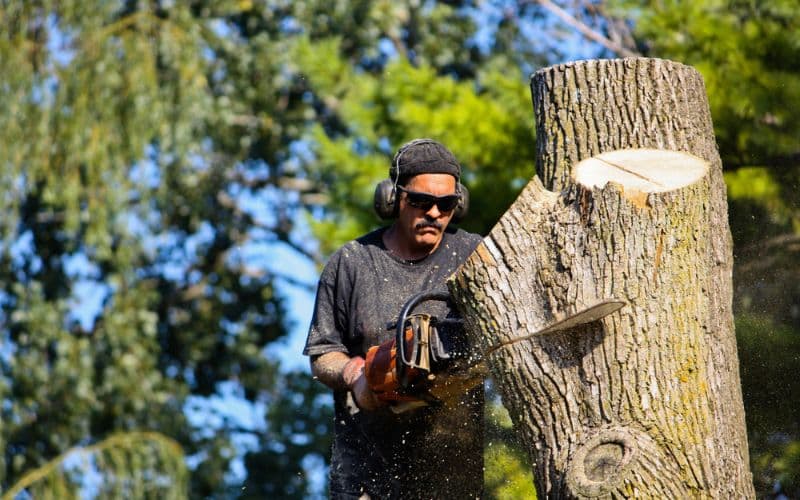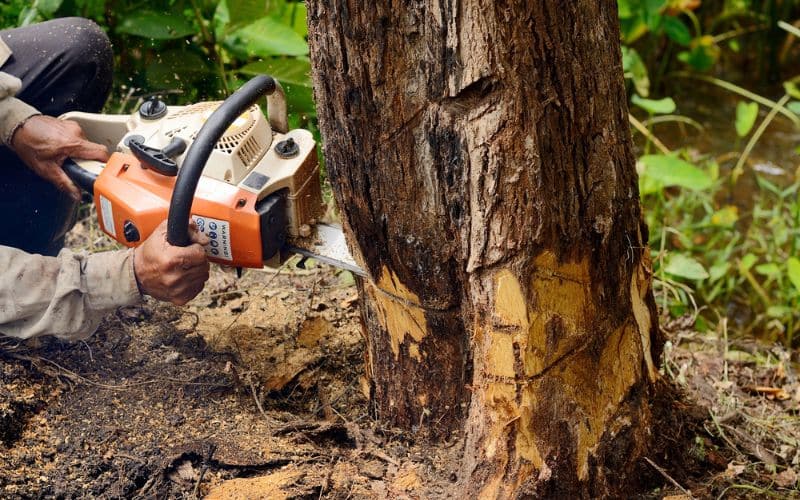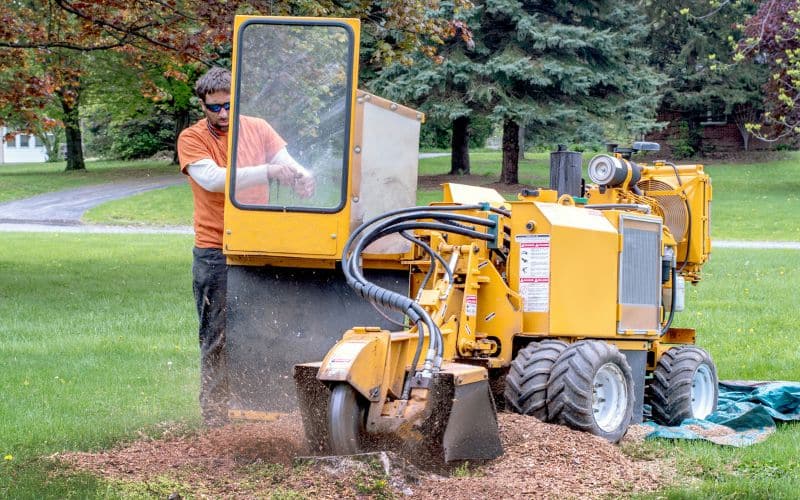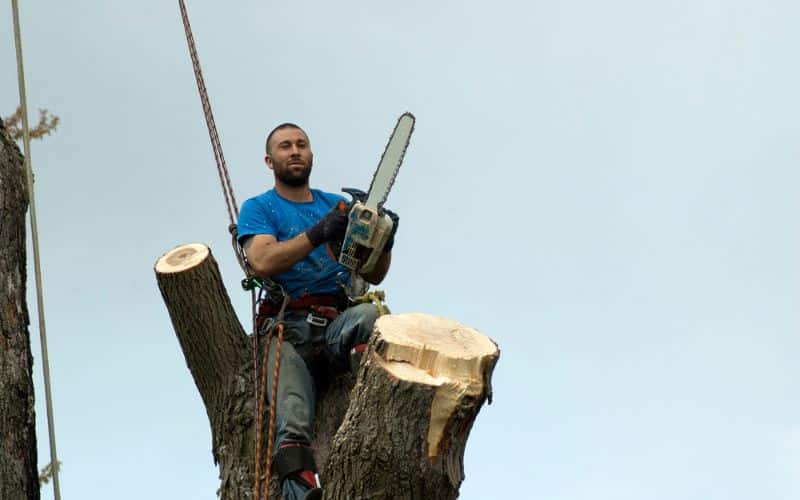
Wondering about the cost to remove that looming tree in your backyard? You’re not alone. Tree removal services can set you back anywhere from $300 to $2000 on average, a price that varies significantly with the height and condition of the tree. Whether it’s a petite sapling or a towering giant, understanding the costs involved is crucial before you make the call.
Small trees under 30 feet tall might seem manageable, but even they come with a price tag ranging from $150 to $500. On the other hand, if you’re dealing with a large tree stretching over 60 feet, you’re looking at costs between $650 and $2000. Knowing these figures upfront can help you budget accordingly and avoid any surprises when the bill arrives.
Factors Affecting Tree Removal Cost
When you’re looking into tree removal services, it’s not as straightforward as a single figure. Several pivotal elements come into play that have a direct impact on the final bill you’ll receive.
Tree Size
The size of the tree is often the most influential factor in the cost of removal. Logically, larger trees demand more resources to take down.
- Small trees (<30 feet): $150 – $500
- Large trees (>60 feet): $650 – $2000
As trees grow in height, they generally become broader and heavier, requiring extra time, manpower, and machinery.
Location and Accessibility
Where your tree stands significantly dictate the ease with which it can be removed:
- Remote areas: Access difficulty may hike up costs due to increased effort to transport equipment.
- Urban locations: Expect increases for traffic control and permits.
Tree Condition
A tree’s health and structural integrity can either simplify or complicate its removal:
- Diseased, rotting, or insect-infested trees need more care and time to remove, often requiring specialized equipment.
Tree Type
Certain species of trees are inherently tougher to remove:
- Oak trees tend to be more robust and expensive to take down compared to pine trees which are generally less complex to remove.
Cleanup Requirements
What happens post-removal is an aspect not to overlook. The cost often covers cleanup, which can vary in difficulty depending on the tree’s location.
Emergency Removal
In situations where a tree poses an imminent threat, emergency tree removal services are available at a higher cost. Urgent tree removal averages around $2,500, a significant increase from planned operations.
Geographic Location also influences the price, with remote areas potentially incurring higher transport costs, while urban settings might attract additional fees for permits and specialized equipment needs.
Additionally, removal in hard-to-reach areas such as hills or heavily wooded sections can escalate the cost further. It is crucial to consider these varying factors to get a realistic estimate for removing a tree from your property.
Type of Tree
When considering the costs of tree removal, the type of tree plays a fundamental role in determining the price. Factors such as size, species, and health condition of the tree will shape the complexity and thus the cost of the job required.

Size of the Tree
The size of the tree significantly affects the removal process. Smaller trees typically cost less to remove due to the shorter time and fewer resources needed. Medium-sized trees, standing between 30 and 60 feet, require more labor and may entail the use of additional equipment. Conversely, large trees exceeding 60 feet present increased complexities, often requiring cranes and heavy machinery. Here’s a quick breakdown of average removal costs based on size:
| Tree Height | Average Removal Cost |
|---|---|
| Up to 30 feet | $150 – $500 |
| 30-60 feet | $650 – $1000 |
| Over 60 feet | $1000 – $2000 |
Tree Species
The tree species directly influences the removal cost because of the variance in wood type and tree structure. Softwood trees like pines, which typically range from 50 to 80 feet in height, may cost between $250 and $1500 to remove, depending on their size and complexity. Hardwood trees, such as maples and poplars, can be more challenging to cut due to their dense wood and may cost anywhere from $1000 to $2000.
| Tree Type | Wood Type | Average Tree Height | Total Cost to Remove |
|---|---|---|---|
| Pine | Softwood | 50-80 feet | $250 – $1500 |
| Maple | Hardwood | 40-60 feet | $1000 – $2000 |
| Poplar | Hardwood | 50-80 feet | $1500 |
| Palm | N/A | 32-50 feet | $200 – $900 |
Palms, unique in their cellular structure, can be easier and cheaper to remove compared to their hardwood or softwood counterparts.
Tree Health and Condition
The health and condition of a tree are crucial in assessing removal costs. Trees that are diseased or have extensive damage may pose additional risks, which in turn can require more careful planning and execution. In contrast, a healthy tree might be simpler to remove. An ISA Certified Arborist can evaluate the tree’s species, health, and the extent of damage to determine whether a tree requires removal. Critical factors include:
- Tree Species: Certain species may be more susceptible to breaking or infestation.
- Health of the Tree: A tree with more than half its structure in decline may need removal.
- Trunk Damage: Significant cracks or damage may necessitate removal.
- Hollowness: Over 30% hollowness could compromise the tree’s stability.
- Dead Branches: Less than a quarter of damage might only require pruning, but more could indicate severe issues.
- Position and Number of Dead Branches: Concentrated dead branches on one side could be a sign of disease or structural damage.
- Leaning Trees: Those leaning excessively can present formidable safety hazards.
Location and Accessibility
Tree Location
Your tree’s positioning significantly impacts the cost of removal. Factors such as proximity to power lines, buildings, or public roads alter the complexity of the job. If your tree is in an open space, costs tend to be lower due to easier access. However, in denser urban areas or properties with restricted space, accessibility challenges can arise, escalating costs due to the need for additional safety measures and equipment.
| Location Type | Cost Impact |
|---|---|
| Open space | Lower costs |
| Urban area | Higher costs due to limited space |
| Near power lines | Higher costs due to safety concerns |
Accessibility to the Tree
The accessibility of the tree on your property directly affects how effortless or challenging the removal process will be. Specifically, consider the terrain where the tree stands. A steep incline, for instance, may necessitate special machinery, which can increase the overall price. Trees positioned further from the road or in a backyard often require contractors to navigate the tree pieces through tight spaces, which can add labor time. By ensuring clear access and removing any physical barriers, you might reduce risks and potential costs.
- Easy access from a street equals a reduction in the price.
- Barriers like fences or garden features could increase the price.
Complexity of the Job
Surrounding Obstacles
Obstacles surrounding a tree set to be removed can turn a straightforward job into a complex operation, requiring meticulous planning and execution. Removal complexity increases with each obstacle due to the precision needed to ensure a safe and effective job.
- Trees in Poor Condition: Trees that are leaning, dead, or have other structural issues pose significant risks during removal.
- Limited Space: If there’s little room to fell a tree, it may need to be taken down in sections, which necessitates a higher level of expertise.
- Other Trees: Nearby trees can hamper work by blocking access or creating hazards for falling branches.
These challenges are factored into the cost, accounting for the additional time and specialised equipment needed.
Power Lines
When a tree is intermingled with power lines, the stakes are high. Safety is the priority, with the goal to protect both workers and nearby residents from electrical hazards:
| Situation | Consideration |
|---|---|
| Tree branches near power lines | Removal must be conducted by professionals using non-conductive tools to avoid the risk of electrocution. |
| Large tree removal near power lines | Involves de-energising and grounding power lines or employing protective barriers to prevent outages or accidents. |
The cost increases as these procedures are more labour-intensive and require coordination with utility companies.
Buildings or Structures Nearby
The proximity of buildings or structures to the tree needing removal adds layers of complexity:
- Access for Heavy Machinery: Cranes and other heavy removal equipment need clear access, which may be limited in developed areas.
- Property Damage: Professionals must navigate the risk of property damage, necessitating careful planning and sometimes smaller, more precise equipment.
- Work in Stages: Larger trees may need to be removed in stages to prevent damage to structures, with each section carefully cut and lowered to the ground.
Tree Removal Methods
When you’re considering tree removal, understanding the different methods available can help you make an informed decision. Each technique varies in complexity, cost, and suitability for specific situations.
Climbing and Disassembling Method
This traditional approach involves arborists climbing the tree and removing it piece by piece. It’s often used for trees in confined spaces where felling is impossible. Here’s what you need to know:
- Precision Control: Arborists can carefully cut and lower each part of the tree, avoiding damage to nearby structures.
- No Heavy Machinery: Eliminates the need for cranes, making it cost-effective in certain scenarios.
- Safety Considerations: Highly skilled professionals are needed due to the increased risk involved with climbers working at heights.
This method’s cost can range from approximately $50 to $125 per hour, influenced by the tree’s size and condition.
Crane-assisted Tree Removal
For larger trees or those in particularly challenging locations, crane-assisted removal becomes necessary. Below are key points about this method:
- Efficiency: Can remove trees faster than manual climbing.
- Minimised Damage: Reduces the risk of property damage as the tree is lifted away from obstacles.
- Higher Cost: Expect to pay an additional $500 to $2,500 per day for crane services, given the operation’s scale and machinery involved.
Keep in mind, if the area around the tree can’t support the crane’s weight, alternatives must be used, potentially increasing the cost.
Tree Felling Method
When space allows, the entire tree can be cut at the base and brought down in one piece. Consider the following:
- Cost-Effective: Generally the least expensive method if condition and location permit.
- Quick Removal: Suitable for clear areas where the tree can safely fall.
- Potential Hazards: Incorrect calculations can lead to property damage or injury.
If opting for this method during off-peak seasons, you might benefit from a reduction in rates, with discounts of 10% or more being common in winter months.

Additional Services
When you engage tree removal services, you’ll find a range of additional offerings that can enhance your property’s aesthetics and health. The base cost for tree removal often doesn’t cover these services, but they can provide significant value. Let’s break down the costs and benefits associated with each.
Stump Removal
Once the main body of the tree is removed, you’re often left with a stump. Stump removal is crucial to prevent pest infestations and to clear the way for new plantings or landscaping elements. It’s a complex job that takes into account the stump’s diameter and the root system’s intricacy.
- Cost: You could be looking at spending anywhere between $60 and $350 per stump. However, expect cheaper rates for decaying stumps compared to solid ones.
- Process: Arborists might use a stump grinder to mechanically shred the stump below the soil surface. Thorough stump removal generally employs more invasive techniques to extract the root system.
Branch Chipping
After a tree comes down, you’ll have branches and limbs to contend with. Branch chipping recycles this waste into chips suitable for mulch or other landscaping projects.
- Benefits:
- Costs: If the tree service owns a chipper, this service may not add much to your bill. Without a chipper on hand, you might pay an additional $75 or so.
Hauling and Disposal
The aftermath of a tree removal can leave you with a significant amount of debris. Hauling away logs, limbs, and leaves ensure your property remains tidy and safe.
- Debris Hauling: Costs range from $75 to $250 per trip, depending on the volume of debris.
- Wood Chipping: If included in stump removal services, costs could run from $100 to $500 for the entire tree. This service provides an eco-friendly option for repurposing the tree’s material.
Conclusion
Understanding the costs involved in tree removal helps you budget effectively for this essential service. Remember to factor in the size, condition, and location of your tree when seeking quotes. It’s crucial to ask about additional services that might not be included in the initial estimate to avoid unexpected expenses. By gathering multiple quotes and ensuring you’re dealing with reputable companies, you’ll be able to make an informed decision. With the right preparation, you’re set to tackle your tree removal project with confidence.
Colin Macmillan is a seasoned entrepreneur and the CEO of Riverwood Landscape, a leading landscaping company based in Canada. He has been at the helm of the company since leaving high school, demonstrating his strong leadership skills and business acumen.
Colin’s expertise lies in various aspects of landscaping, including lawn care, interlocking, sod installation, and commercial maintenance. His hands-on approach and dedication to the craft have been instrumental in building Riverwood Landscape into a reputable brand.
One of his most notable achievements is the creation of a successful landscape franchise that services multiple locations. This accomplishment underscores his strategic thinking and ability to scale operations effectively.
Colin has also had the privilege of working with Guelph Hospital for landscaping and maintenance, a testament to the trust and reliability that his company has earned over the years.
His professional mission is to offer the best services and experiences for customers, a goal that he tirelessly pursues. Colin’s commitment to excellence and customer satisfaction continues to drive the growth and success of Riverwood Landscape.









